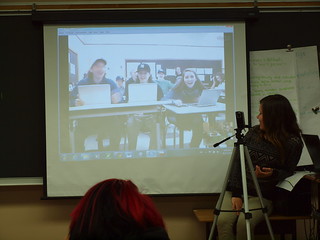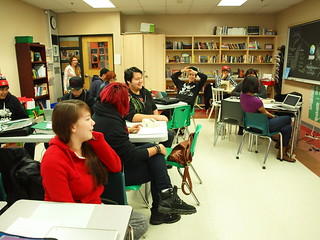This past week my ENG3C class participated in a Mystery Skype with another Ontario grade 11 class. There are so many directions this post can take:
- What happens when you have a PLN…
- What happens when you say “Yes” to your PLN…
- What happens when your colleagues believe in the work you do…
- What happens when the technology fails you…
- What happens when the students are collaborators in the design of the event…
- What happens when students are willing to risk themselves to share a bit of who they are…
- What happens when it’s over…
But, today I want to focus on what happens when we understand the power of technology integrated into our teaching and our students’ learning.
We have been using some technology in our class this semester. A wiki that houses lessons, video, and other resources, Google docs, and recently Twitter and Edublogs . Much of this tech integration is straight-up substitution, and although students are enjoying tweeting out learning goals and daily takeaways, and having access to the Internet in the classroom via Chromebooks, the interaction still falls into the ‘fun and games’ category. I cringe every time I am asked if my students are more engaged because of the technology in my room.
In reality, it has taken us months to feel comfortable using Chromebooks, to understand Google Drive, and to incorporate any of the tech and tools into our day. We have not yet had enough experience using the Internet and its products as learning resources. Social media platforms continue to be used strictly for personal use, so bringing them into the learning environment did cause some surprise. And what they did not impact at all was our intellectual engagement with the course big ideas, questions, and materials. There have been no sparks, no meaningful connections, no newly discovered rabbit holes.
When Sarah Le tweeted me about the possibility of running a Mystery Skype with our two English classes with the ultimate goal of having a conversation about First Nations stereotypes, my antennae began to crackle. Here was an opportunity to test the power of flattening the walls, engaging authentically, and creating conversation for learning. And yet, what underpins all of this is our ability to think…to plan, to predict, to design, to gather appropriate resources, to problem solve, to collaborate, to take risks. This event, then, was not about technology, at least not wholly.
We had plenty of time to get ready for the big day. We had assigned roles, prepped questions, vetted the other class’ questions, gathered some resources, and held a dry run of the event. The Internet was a bid dodgy, but otherwise, the students felt they were ready. We weren’t. The second the call ended, students began to evaluate their performance.
“We needed to have better questions prepared.”
“We needed to have thought through a strategy to help us figure out where they were.”
“We needed to be better at responding to questions.”
“We need to be better organized.”
“We need to communicate more with each other.”
In under an hour, students recognized and articulated their learning needs; the same learning needs that I have spent the last two months teaching to. The difference? I think their expressions say it all.



I loved the direction you took with your post. It never occurred to me that one activity could take so many directions. I guess that is what happens when you pursue an activity with the potential to be rich.
I admire your honesty about the role of technology in the classroom. It can be very difficult to use technology in a meaningful way; a way that goes beyond substitution, like you say. For example, I’m struggling to make blogging work in my classroom. I think the act of blogging is important, but getting students to “buy in” to expressing their voices is hard. Similarly, getting students to engage in conversation via each others’ blogs is a greater challenge. Blogging is a way the technology can enhance learning, but getting students to use it in such a way is the tricky part.
I’m impressed that your students began to reflect on the Skype immediately afterwards. It took some time to get my students to have a conversation about it, but once they began blogging about the Skype, they came to similar conclusions as your class.
PS The picture is awesome!
LikeLike